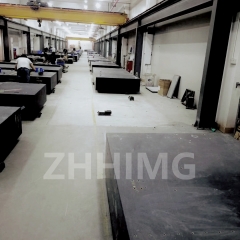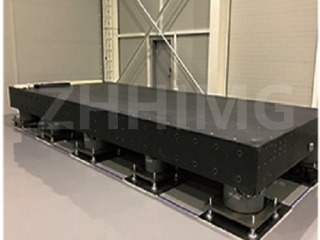In the world's top laboratories, whether it is the detection of nanoscale materials, the calibration of precision optical components, or the microstructure measurement of semiconductor chips, there are almost strict requirements for the accuracy and stability of measurement references. Granite straightedge, with its outstanding performance, has become the first choice for many laboratories. Compared with traditional cast iron reference surfaces, its precision stability can be improved by up to 300%, which is based on profound scientific evidence and practical verification.
1. Material properties determine the basis of precision
Cast iron, as a traditional reference surface material, although it has certain rigidity, has inherent defects. Its coefficient of thermal expansion is approximately 12×10⁻⁶/℃. Under the common temperature fluctuation environment in the laboratory (such as a 5℃ temperature difference caused by the start and stop of air conditioners), a 1-meter-long cast iron reference surface may undergo a dimensional change of 60μm. In addition, there are flake graphite structures inside cast iron. Long-term use is prone to stress concentration, resulting in a gradual decrease in the flatness of the reference plane. This kind of thermal deformation and structural change will cause systematic deviations in the measurement data, seriously affecting the accuracy of the experimental results.
In contrast, the coefficient of thermal expansion of granite straightedge is only (4-8) ×10⁻⁶/℃, which is less than one-third of that of cast iron. Under the same temperature difference of 5℃, the size change of a 1-meter-long granite straightedge is only 20-40 μm. Granite is formed by the crystallization of minerals such as quartz and feldspar. It has a dense and uniform structure and no problem of internal stress concentration. After billions of years of geological processes, granite has naturally aged and will not deform like cast iron over time, ensuring the long-term stability of the reference plane from the essence of the material.

Second, the processing technology achieves ultra-high precision
During the processing of cast iron reference surfaces, due to the limitations of material properties, the flatness accuracy usually can only reach ± 5-10 μm. Moreover, the surface of cast iron is prone to oxidation and rusting, requiring regular maintenance and grinding. Each grinding will affect the original accuracy of the reference surface.
Granite straightedge adopts high-precision grinding technology and is combined with advanced numerical control processing technology. The flatness can be controlled within ± 1-3 μm, and some high-end products can even reach ±0.5μm. Its surface hardness reaches 6 to 7 on the Mohs scale, and its wear resistance is 3 to 5 times that of cast iron. It is not easily scratched or worn. Even after long-term use, the surface accuracy of the granite straightedge can remain stable, eliminating the need for frequent calibration and maintenance, significantly reducing the laboratory's usage cost and time cost.
Iii. Environmental adaptability ensures stable measurement
The laboratory environment is complex and changeable. Factors such as humidity, vibration and electromagnetic interference can all affect the measurement accuracy. The cast iron reference surface is prone to rust in a humid environment, resulting in an increase in surface roughness and affecting the contact accuracy of the measuring probe. Meanwhile, the magnetism of cast iron can interfere with the operation of precision electronic measurement equipment.
Granite straightedge is a non-metallic material, non-magnetic and non-conductive, and will not interfere with electronic devices. Its water absorption rate is less than 0.1%, and it can still maintain stable performance in a high-humidity environment. In addition, the unique damping properties of granite can effectively absorb environmental vibrations and minimize external disturbances. For instance, in a laboratory close to large-scale instruments and equipment, a granite straightedge can attenuate over 90% of the vibration energy within one second, while a cast iron reference surface requires 3 to 5 seconds. This enables the granite straightedge to provide a stable reference for measurement even in complex environments.
Four. Actual data verifies performance advantages
A well-known international semiconductor laboratory once conducted a long-term comparative test on cast iron and granite reference surfaces: During the measurement experiment that lasted for 30 days and lasted for 8 hours each day, the cumulative measurement error of the equipment using the cast iron reference surface reached ±45μm. The equipment using granite straightedge has a cumulative error of only ±15μm, and the improvement in precision stability is as high as 300%. Similar experimental results have been repeatedly verified in top laboratories in multiple fields such as materials science and optical engineering, further demonstrating the irreplaceability of granite straightedge in high-precision measurement.
In conclusion, the granite straightedge has comprehensively surpassed the cast iron reference surface by virtue of its triple advantages of material properties, processing technology and environmental adaptability. Its 300% improvement in precision stability not only provides a reliable measurement benchmark for laboratories but also lays a solid foundation for the development of cutting-edge scientific research and precision manufacturing technology. This is precisely the core reason why the world's top laboratories have all chosen granite straightedges.
Post time: May-19-2025

